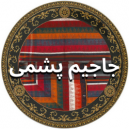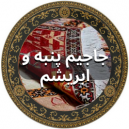Reviews
No data found
Jajim is a type of reversible blanket made from colorful and delicate wool or cotton threads. These handwoven textiles are free of pile and can be used on both sides. They are typically used as throws and for protection against cold. In the past, jajims were more commonly used when chairs were prevalent, serving as covers for wooden chairs. With changes in lifestyle and home heating methods, the use of jajims has declined.
Jajim weaving is one of our country's most famous crafts, produced in various rural areas. It can be said that jajim handicrafts are among the arts that attract many enthusiasts both inside and outside our country's borders. Describing the necessary tools and equipment for weaving jajim, we can say that each climate and region employs its own unique method and design.
Jajims were traditionally used in villages and cities in various colorful stripe patterns and diamond-shaped motifs, considered popular underlays. Today, jajim production is carried out entirely professionally and for commercial purposes, with various workshops producing these jajim products and offering them for sale in physical and online handicraft stores. Some customers may even seek to purchase vintage and used jajims with unique and beautiful designs.
Materials and Equipment Needed for Jajim Weaving:
The primary material used for weaving jajim is wool, and its weaving is similar to kilim, but the difference between these two handwoven textiles is that jajim is woven in four panels and then connected and stitched together.
Jajim weaving machine
Loom
Beater
Gilan comb
Comb
Sword
Rod
Sardar (a tool)
Heddle
Dara july (a tool)
Maku (a tool)
Where does the term "jajim" come from?
The word "jajim" is derived from the word "jajam." The word "jajim" linguistically returns to "jajem," and its meaning is similar to the word "plas." In various regions of Iran, jajim is woven, leading to different names for it in each city.
Meanwhile, jajim is also industrially produced, using synthetic fibers, new equipment, and synthetic colors for weaving. It can be likened to machine-made carpets produced in various factories across the country.
Jajim has various uses, including as bedding, blankets, carpets, and underlays. Nomadic tribes in Iran use jajim for packing their belongings during migration and camping. Moreover, in Iran, jajim is mostly used as chair coverings and bedding. In different cities of the country, jajim is woven in different patterns, colors, and sizes. Jajim weaving is thick, and because it does not produce pile, it can be used on both sides. In rural areas, jajim is a common valuable gift for newlyweds.
The length of weaving in Jajim is higher while its width is narrower.
Thin and long pieces are stitched together.
Kilim is woven uniformly and consistently.
Kilim is thicker than Jajim.
Jajim is thinner and more delicate compared to Kilim.
Its thickness resembles that of an abaya.
Due to its warp and weft weaving, Jajim patterns are generally horizontal and vertical.
Jajim has fewer fringes compared to Kilim, and its fringes are more delicate.
In Jajim weaving, the fringe comb is usually colorful, enhancing its beauty.
In regions where Jajim weaving is prevalent, it comes in various sizes and patterns, each featuring unique and colorful designs.
One of the most common designs is the four-panel or simple Jajim. Patterns such as Jajim flowers, cones, pathways, and four squares are woven on it, with various colors. Notable designs include pathways, four-square or checkerboard patterns, Jajim flowers, and cones, all featuring vibrant and joyful colors.
This type features a special and beautiful style, known as "six-thread," typically using colors such as indigo, white, and black.
Another type is needlework Jajim, which incorporates Kilim patterns, usually made from wool. These Jajims feature eye-catching patterns like peacocks, flowers, and flower buds.
This design is one of the most famous and beautiful types of Jajim weaving. Intricate patterns like peacocks, flower buds, and flowers are used, captivating any viewer's attention.
Plain Jajims also exist, mostly featuring pathways and using only different colors.
Jajim patterns are often pathways, and their motifs are colloquially called "secrets," created by weavers using flower and plant shapes. Although the unique technical features of Jajim weaving significantly limit the choice of patterns, traditional designs with vertical colored stripes of varying thicknesses justify the repetition of decorations, reflecting auspicious and magical concepts: a series of small geometric patterns like stars, diamonds, octagons, and triangles, as well as everyday objects like combs, or geometrically patterned talismanic objects similar to pendants used by nomads as jewelry.
The most common handwoven Jajims are Qashqa'i, simple, or four-panel, which come in various patterns:
Pathway, four-square or checkerboard, Jajim flowers, cones, such as peacocks, flower buds, and flowers.
In Lorestan, Jajim is called "Mashteh weaving," and its common patterns include floral motifs, four-square, "Water and Tree" (Ab and Dar), pathways, eight houses, and pentagonal houses.
In Almout, Jajims with cloud and nightingale patterns are woven, while in Bouye Zahra, plain Jajims are more common.
Jajim can be categorized based on the materials used into four types: woolen Jajim, wool and cotton Jajim, silk and cotton Jajim, and fully silk Jajim.
This type of Jajim is woven from woolen threads and is usually used in colder regions. What distinguishes these Jajims from other types is not only their pile-free weaving but also the use of woolen materials and four-panel weaving. After weaving, its pieces are connected and stitched together.
To view all woolen Jajims in the online handmade carpet market, you can click here.
In this type of Jajim, the warp is made of cotton thread, and the weft is made of woolen thread.
For viewing wool and cotton Jajims in the online handmade carpet market, you can click here.
In this type of Jajim, the warp is made of cotton thread, and the weft is made of silk thread.
For viewing silk and cotton Jajims in the online handmade carpet market, you can click here.
This type of Jajim is rare and decorative, woven entirely from silk thread for both warp and weft.
For viewing fully silk Jajims in the online handmade carpet market, you can click here.
میلیون – میلیون
No items found matching the search criteria
No items found matching the search criteria
No items found matching the search criteria
No items found matching the search criteria
No items found matching the search criteria
No items found matching the search criteria
No items found matching the search criteria
No items found matching the search criteria
شرکت ما با بیش از 65 سال سابفه در زمینه خرید و فروش و صادرات فرش دستباف از 5 سال قبل فعالیت خود را بر روی بازار های انلاین متمرکز نمود و در همین راستا بازار دفه زن شکل گرفته است.
هدف این بازار ایجاد ارتباط مستقیم بین تولید کنندگان و فروشندگان فرش دستباف ایرانی از یک سو و خریداران داخل ایران و خریداران خارج از ایران و فروشگاه های فرش دستباف در خارج از ایران از سوی دیگر می باشد



